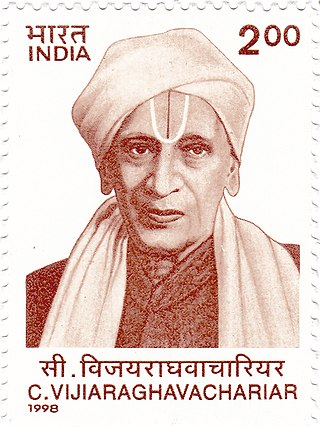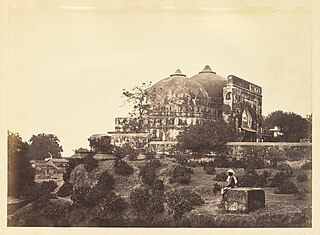The Justice Party, officially the South Indian Liberal Federation, was a political party in the Madras Presidency of British India. It was established on 20 November 1916 in Victoria Public Hall in Madras by Dr C. Natesa Mudaliar and co-founded by T. M. Nair, P. Theagaraya Chetty and Alamelu Mangai Thayarammal as a result of a series of non-Brahmin conferences and meetings in the presidency. Communal division between Brahmins and non-Brahmins began in the presidency during the late-19th and early-20th century, mainly due to caste prejudices and disproportionate Brahminical representation in government jobs. The Justice Party's foundation marked the culmination of several efforts to establish an organisation to represent the non-Brahmins in Madras and is seen as the start of the Dravidian Movement.
The anti-Hindi-imposition agitations in Tamil Nadu have been ongoing intermittently in the southern Indian state of Tamil Nadu since the early 20th century. The agitations involve several mass protests, riots, student and political movements in Tamil Nadu concerning the official status of Hindi in the state.

Hindu Munnani is a right-wing Hindu nationalist organisation based in the Indian state of Tamil Nadu. Hindu Munnani was set up by Rashtriya Swayamsevak Sangh (RSS) The organisation was founded in 1980 by Ramagopalan, a member of RSS and since its formation served as the platform for RSS and its subsidiaries known as the Sangh Parivar.
The cow protection movement is a predominantly Hindu religion and political movement aiming to protect cows, whose slaughter has been broadly opposed by Hindus, Buddhists, Jains, Zoroastrians and Sikhs. While the opposition to slaughter of animals, including cows, has extensive and ancient roots in Indian history, the term refers to modern movements dating back to colonial era British India. The earliest such activism is traceable to Namdhari (Kooka) Sikhs of Punjab who opposed cow slaughter in the 1860s. The movement became popular in the 1880s and thereafter, attracting the support from the Arya Samaj founder Swami Dayananda Saraswati in the late 19th century, and from Mahatma Gandhi in the early 20th century.

Chakravarti Vijayaraghavachariar was an Indian politician. He rose to prominence following his appeal against the false charges alleging him to have instigated a Hindu – Muslim riot in Salem. The legal battle and eventual victory in proving his innocence earned him the title The Lion of South India.
The Nagpur riots of 1927 were part of series of riots taking place across various cities in British India during the 1920s. Nagpur was then the capital of Central Provinces and Berar (CP&B) state of British India which covered most of the central India. The riots occurred on 4 September 1927. On that day, there was a procession for Mahalakshmi, which was blocked by Muslims when it came to the Mahal neighbourhood. In the afternoon, there was rioting near the Hindu houses of the neighbourhood, which continued for three days.

The Malabar rebellion of 1921 started as a resistance against the British colonial rule in certain places in the southern part of old Malabar district of present-day Kerala. The popular uprising was also against the prevailing feudal system controlled by elite Hindus.

The demolition of the Babri Masjid was carried out on 6 December 1992 by a large group of activists of the Vishva Hindu Parishad and allied organisations. The 16th-century Babri Masjid in the city of Ayodhya, in Uttar Pradesh, India, had been the subject of a lengthy socio-political dispute, and was targeted after a political rally organised by Hindu nationalist organisations turned violent.
The Indian independence movement had a long history in the Tamil-speaking districts of the then Madras Presidency going back to the 18th century.
The 1915 Sinhalese-Muslim riots was a widespread and prolonged ethnic riot in the island of Ceylon between Sinhalese Buddhists and the Ceylon Moors. The riots were eventually suppressed by the British colonial authorities.

The 1985 Gujarat riots began in February 1985 and lasted till August, in the Indian state of Gujarat. Most of the rioting occurred in the city of Ahmedabad; some other cities, including the state capital of Gandhinagar, were also affected. Between 220 and 275 people were killed in the violence, while several thousands of others were injured, and tens of thousands were displaced. The riots also caused widespread property damage.
The 1970 Bhiwandi riots were religious riots which occurred between 7 and 8 May in the Indian towns of Bhiwandi, Jalgaon and Mahad, between Hindus and Muslims. The riots caused the deaths of over 250 people; the Justice Madon commission, which investigated the riots, stated that 142 Muslims and 20 Hindus had been killed in Bhiwandi alone, and 50 Muslims and 17 Hindus in the surrounding areas. The commission strongly criticized the police for anti-Muslim bias in the aftermath of the riots, and also criticized the Shiv Sena, a Hindu-nationalist political party, for its role in the violence.
There have been several instances of religious violence against Muslims since the partition of India in 1947, frequently in the form of violent attacks on Muslims by Hindu nationalist mobs that form a pattern of sporadic sectarian violence between the Hindu and Muslim communities. Over 10,000 people have been killed in Hindu-Muslim communal violence since 1950 in 6,933 instances of communal violence between 1954 and 1982.

The Ram Rath Yatra was a political and religious rally that lasted from September to October 1990. It was organised by the Bharatiya Janata Party (BJP) and its Hindu nationalist affiliates, and led by the then-president of the BJP, L. K. Advani. The purpose of the yatra was to support the agitation, led by the Vishwa Hindu Parishad (VHP) and its affiliates in the Sangh Parivar, to erect a temple to the Hindu deity Rama on the site of the Babri Masjid.
In October 1990, there was a major communal riot in Bijnor, a town in the state of Uttar Pradesh, India. Stemming from a celebratory procession by local Hindu groups, it was the most destructive riot in the wake of concurrent Hindu nationalist campaigns, which eventually led to the demolition of Babri Masjid. The riots were also characterized by phases of passive and active complicity of the state machinery.
During the 1990 Madras riots, violence broke out between Muslims and Hindus during a Hindu religious procession near a Mosque in September 1997 in Triplicane, Tamil Nadu. Three Muslims were reported to be killed in the violence. Unofficial reports place the death toll to five to six. Muslim owned stores were burned down and looted.

Rama Navami is a Hindu festival celebrating the birthday of Hindu deity Rama. It falls on the 9th day of the Chaitra month every year in the Hindu calendar, usually during the months of March–April. At least since 1979, if not earlier, this festival has involved carrying out processions throughout the cities, which also enters into Muslim dominated areas sometimes as a way to show Hindu strength. These procession by Hindus, often considered offensive by the Muslims, have repeatedly led to violence between Hindu and Muslim communities.
A Hindu–Muslim clash occurred in Delhi's Jahangirpuri area on 16 April 2022, in the midst of a Hindu procession on the occasion of Hanuman Jayanti. The clash took place during the last of three processions organised that day by Bajrang Dal, a right wing Hindu group nationalist organization. The procession, whose members were reportedly brandishing swords and pistols, halted near a mosque where Muslims were holding Ramadan prayers, while blasting music from loudspeakers and shouting abusive slogans. A conflict broke out, during which both groups pelted the other with stones and other objects; a few shots were fired as well. A number of people were injured, including a police officer. Twenty three people were arrested, including two juveniles.
On 10 April 2022, a clash between Hindus and Muslims occurred in the city of Khargone, Madhya Pradesh. It took place between 5:00 pm and 6:00 pm, in the midst of a Ram Navami procession organised by a Hindu nationalist organisation allied to the ruling Bharatiya Janata Party (BJP). At 5:00 pm, when Muslims were gathering for evening prayers at the neighbouring Jama Masjid, the procession had not yet departed from the city's central Talab Chowk area.
The Egmore group, also faction, clique, or set, was a faction in the Madras Presidency which emerged as opposition to the hegemony of the Mylapore clique, crystallizing around the leadership of C. Sankaran Nair — one of the first non-Brahmins to achieve high office in British India. S. Kasturi Ranga Iyengar, editor-owner of The Hindu, was another crucial early ‘Egmorean’, as was C. Rajagopalachari, who ultimately ousted the Egmore group from the position of power it had achieved in the Madras Presidency wing of Indian National Congress, the origins of which substantially lie in the Mylapore-Egmore rivalry. Additional pivotal figures in the early Egmore faction were T. Rangachari, C. Vijayaraghavachariar, and T. M. Nair. Along with the neutral Triplicane Clique of Ramarao and M. O. Parthasarathy Iyengar, Mylapore and Egmore were often referred to as Madras' 'Three Inns of Court', paralleling London's Gray's Inn, Lincoln's Inn, and Middle Temple. During the Home Rule movement, Mylapore and Egmore were briefly allied, although this failed to last. The nationalists of the Salem Clique led by Rajaji wrestled with the Mylapore faction for control over the provincial congress and eventually succeeded with the Gandhian line of engagement.